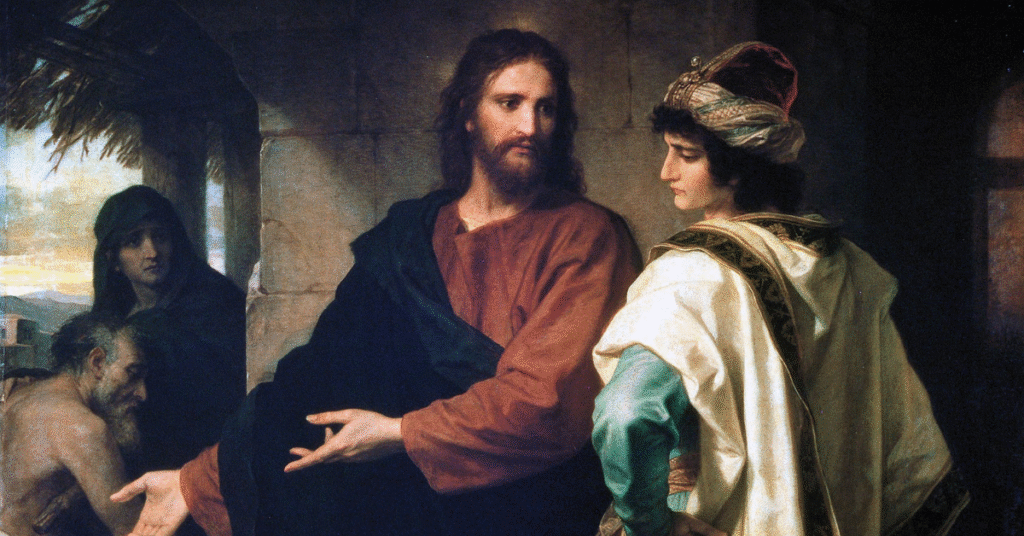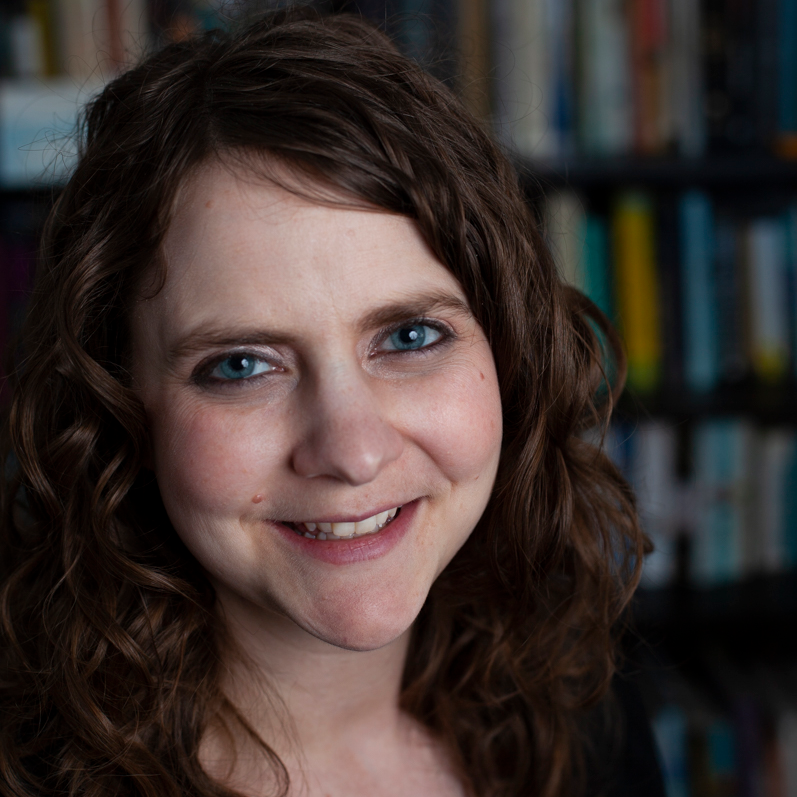For so long the Bible passage about the rich young ruler stalked me. It was the angel (or maybe even the devil?) sitting on my shoulder judging my every decision. It echoed in my head every time I spent money on a “want” over a “need”. It caused me to question just about every financial choice – reminding me that the only “faithful” thing to do was to give it all away. Despite my passion for stewardship and my fervent encouragement to ministry leaders to preach and teach about money in the Bible, if I had ever been asked to preach on this text I would have run for the hills. As much as I tried to avoid it, it was always there hovering right next to me.
I’m guessing I’m not the only person who has scriptures that stalk them, maybe you do, too? I think for many of us the scriptures we most want to avoid are the ones that have to do with money and for good reason! Often the only examples we’ve seen of preaching and teaching on these passages weren’t good ones. We’ve seen these texts used to invoke shame and blame. We’ve heard these texts used to manipulate people into believing that their generous response would curry God’s favor all while lining the preacher’s pockets. And, we’ve seen these texts used as a one-way ticket to get listeners to give more money to the church as if that was the only faithful response.
And yet, as we look more closely at what the Bible has to say it seems to focus on how we live with money, not only how we give it away. Just as our call to faithful stewardship doesn’t begin and end on Sunday morning, our call to live faithfully with money extends to the way we spend, save, and give as well as the ways we regard it and acquire it. The authors of the Bible were curious about the ways money functions in our lives and how that impacts our lives of faith. I wonder what it might look like for us, as people of faith, to join the biblical authors in their curiosity about faith and money? How might we explore what it looks like to use our money faithfully in every area of our life?
Over a period of six months, I had the privilege of working with a group of lay leaders and pastors from a handful of congregations who were interested in exploring this topic together. This Faith & Money Learning Lab helped me to develop a set of spiritual practices that the leaders then tested out in their congregations in small group settings, as a devotion to kick off stewardship and/or leadership team meetings, even in worship. Their feedback and encouragement is what makes this work so rich!
Initially, we struggled a bit with what to focus on. This topic is rich and varied – there were so many different angles to explore. But the group agreed that these practices needed to be oriented around specific scripture passages about faith and money – particularly the ones, like the rich young ruler, that we just don’t know what to do with. Here’s the practice we developed around this passage along with a little commentary from me.
We begin with a guided meditation and prayer centered around God’s love for us. Use all senses to imagine what God’s love feels like to you or remember specific times you experienced God’s love for you. Be creative and playful with this activity, there are no right or wrong answers.
Guided Meditation
I invite you to get into a comfortable position in your chair and close your eyes. We’ll begin by considering what God’s love sounds like. You might recall your favorite verse of scripture, a beloved hymn, or the encouraging words of a friend. You might also hear sound without words like the rustling of leaves or the crash of waves on the ocean. Imagine those words or that sound in your head and listen to it for a few moments. [Silence]
Next we’ll consider what God’s love looks like. You might recall a particular person or place. You might visualize an experience of God’s love in your mind. You might imagine what one of your favorite bible stories looked like. Take a few moments to gaze at that image in your mind. [Silence]
Next we’ll consider what God’s love feels like. If you were to reach out and touch God’s love, what might it feel like? I invite you to get creative. Would it feel like the fur of a beloved pet? The hand of a loved one? The bark of a tree in the woods? Let your mind wander and settle on a particular sensation. Take a few moments to imagine what it feels like to touch God’s love. [Silence]
Next we’ll consider what God’s love smells like. You might choose a smell associated with one of your favorite bible stories (like bread and fish from the feeding of the five thousand or a crackling fire like the Spirit descending on people in Pentecost) or a smell the brings you comfort (like your Grandmother’s apple pie or freshly laundered sheets). Take a few minutes to breathe in the scent of God’s love. [Silence]
We’ll end with tasting God’s love. You might recall the taste of bread or wine from communion. You might imagine a favorite flavor like cinnamon, honey, or garlic, or even a favorite food that reminds you of God’s warm embrace. Take a few minutes to recall the taste of God’s love. [Silence]
O God of infinite, everlasting love, we give thanks for the many ways you are present with us. You use every one of our senses to communicate your love to us. Your love surrounds, empowers, and holds us even in those moments where we can’t detect it. In this time together today, may we experience anew your love for us. Amen.
We often forget what I’ve now come to know as one of the keys to the rich young ruler passage: “Jesus looked him hard in the eye—and loved him!” (Mark 10:21, The Message) This sensory engagement helps learners get out of their minds and into their bodies. It reminds them of God’s real, tangible love for them as well as the rich young ruler.

I Wonder, I Notice
Then we engage in an ancient spiritual practice called: “I Wonder, I Notice.” Begin by reading the Bible passage (Mark 10:17-27, The Message) aloud. The first time, simply listen to the words. The second time, the reader invites the group to interrupt the reading with things they wonder about in the text. Don’t worry they don’t have to be the wonderings of a biblical scholar! They can be about anything that’s going on in the text, don’t limit yourself. There are no right or wrong answers. During the third and final reading of the text, the reader invites the group to interrupt them with things they notice in the text.
This has become one of my favorite spiritual practices for engaging scripture passages that prompt more questions than answers. You’ll be amazed at the ways this simple practice can open up new possibilities in a seemingly straightforward text. It also gives the whole group permission to be curious and even push back on the text – something many of us have never felt permission to do.
The text itself was chosen carefully here. I encourage congregations to read the text not in the version that congregants are most used to – in most cases, The Message paraphrase and The New Living Translation can help us hear the text in a new way without “old tapes” of previous preachers and teachers disrupting our experience. I also think one of the primary reasons we’ve struggled so much with this story is that we’ve cut the passage off before the true ending. We often end it with verse 21: “The man’s face clouded over. This was the last thing he expected to hear, and he walked off with a heavy heart. He was holding on tight to a lot of things, and not about to let go.” What a tragedy! And yet Jesus’ conversation with the disciples continues even after the man leaves. In this practice, we end with verse 27: “Jesus was blunt: “No chance at all if you think you can pull it off by yourself. Every chance in the world if you let God do it.” A beautiful gospel word and a reminder that it isn’t all up to us.
Discussion
After the reading, invite the group to connect with partners to discuss these questions:
- What do you think was the motivation behind the rich young ruler’s questions?
- Do you think Jesus’ command to “Go sell whatever you own and give it to the poor” is this a universal command for all Christians or an individual prescription specifically for the rich young ruler? Or, maybe a little of both?
- What is God’s invitation to you from this passage?
I was surprised to see how question 1 really helped our group to cultivate compassion for the rich young ruler – a character we have so often defamed and despised. In fact, many of us (myself included!) saw a lot of ourselves in him. He’s an earnest, perfectionist – he just wants to know if he’s done it right. Don’t we all yearn to know this? And yet, Jesus reminds him that the life of faith isn’t about checking off items on our “to-do list”. The call to love God and our neighbor can never be completed. It is a question that guides our entire life – every nook and cranny – especially those we’d like to hide from the light.
The second question comes from a sermon by Rev. Dr. Martin Luther King Jr: “Jesus never made a universal indictment against all wealth. It is true that one day a rich young ruler came to him, and he advised him to sell all, but in that instance Jesus was prescribing individual surgery and not setting forth a universal diagnosis.” We’ve often received this as a universal command and yet it was said just to the rich young ruler. What if Jesus wasn’t inviting every Christian to sell everything? Consider all of the people with wealth who helped Jesus and his disciples throughout their ministry. Their wealth made it possible to spread the gospel across Judea, Samaria, and to the ends of the earth. While I don’t think the exact command is for all of us, I do think Jesus has an invitation for each of us in this story.
Ending Prayer
“Transforming God, we give thanks that you see us too and love us – just as you saw the rich young ruler in this story. You know our motivations and meet us where we are in our journey of faith. We know the road to following you isn’t always easy, sometimes it can seem downright impossible. We’re grateful that you go ahead, behind, and beside us paving the way for us. Accompany us as we respond to your specific call for each of us. Amen.”
If you’re curious to learn more about this practice, or any of the others that we developed in the Faith & Money Learning Lab, you can find them in the new Faith+Lead Academy Course: Beyond the Tithe. You can walk through this course on your own or with a group from your congregation. Through this course you will:
- Reframe your understanding of money and stewardship, developing a holistic, Spirit-led approach to finances.
- Recognize God’s abundance in your own story and decisions.
- Develop simple money practices shaped by biblical wisdom and personal calling.
- Reflect on familiar Scripture in fresh, practical ways.
- Identify and take your next faithful, financial step.
We hope this course will be a breath of fresh air that helps you to encounter the texts we’d rather avoid with grace and curiosity. It certainly helped me see the rich young ruler text in a new way. It’s now one of my favorite stories to read and discuss. Now, instead of a stark word of judgement, I hear a love-filled invitation. A reminder that this work isn’t all mine to do, God is with me every step of the way.

